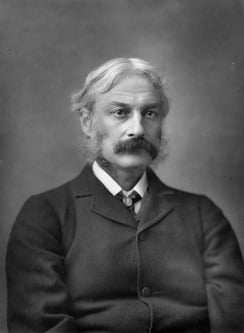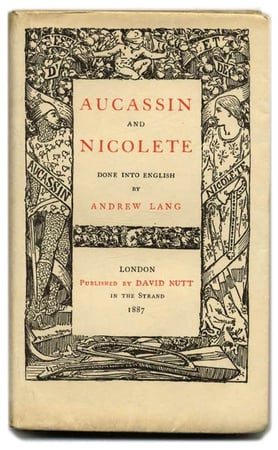To collect Andrew Lang is to be something of a masochist. What else can be said about a man who left his name on over 175 books? Reflecting his encompassing tastes, Lang’s final output ranges from scholarship to poetry, fiction, collaborations, compilations, translations, and beyond. One does not need to be a completist to collect Andrew Lang (if such a goal is even possible), but it does help to have an idea of the author’s rich and vast oeuvre before diving in.
 Andrew Lang was a Scottish professor, journalist, editor, and writer. His work encompasses nearly every literary subject, and his blue plaque in London remembers him, rightfully, as a “man of letters.” If ever anyone earned such a claim to the title, it was he. By looking through his bibliography, which contains writings on history, myth, ideas, anthropology, humor, religion, the classics, and more, one gets the sense there is something in his body of work for everyone.
Andrew Lang was a Scottish professor, journalist, editor, and writer. His work encompasses nearly every literary subject, and his blue plaque in London remembers him, rightfully, as a “man of letters.” If ever anyone earned such a claim to the title, it was he. By looking through his bibliography, which contains writings on history, myth, ideas, anthropology, humor, religion, the classics, and more, one gets the sense there is something in his body of work for everyone.
Much of Andrew Lang’s career was spent as a sort of curator of stories, connecting readers to older texts through new editions which he introduced, translated, and compiled. By and large, these are his most popular works. The irony of Lang’s life, as critic Anita Silvey noted in her book Children's Books and Their Creators, was that “although he wrote for a profession—literary criticism; fiction; poems; books and articles on anthropology, mythology, history, and travel ... he is best recognized for the works he did not write."
Scholarship and Editing
 Lang paid tribute to writers and figures he admired by dedicating some book or other to them, whether it was a compilation, a commentary, or otherwise. In his vast career, he paid reverence to Homer, Joan of Arc, Walter Scott, and excerpted an elegant chapter from the historian Herodotus in the book Euterpe.
Lang paid tribute to writers and figures he admired by dedicating some book or other to them, whether it was a compilation, a commentary, or otherwise. In his vast career, he paid reverence to Homer, Joan of Arc, Walter Scott, and excerpted an elegant chapter from the historian Herodotus in the book Euterpe.
Lang also leaves behind a significant body of curated stories. In 1887, he translated and commented on a version of Aucassin and Nicolette, a delightful medieval French romance. In a similar vein, Lang dedicated at least two volumes to tales of King Arthur and the Round Table, as well as one to the Arabian Nights. He wrote a sharp introduction to The Secret Commonwealth of Elves, Fauns, and Fairies, a 17th century work of folklore. Owing to the prominence and significance of these stories, fine editions of these books are coveted by collectors and typically fetch hundreds of dollars.
Original Work
Lang contributed to anthropological study, and his works in this field shed light on his trademark concern—fairy tales. He wrote the books Custom and Myth (1884) and Myth, Ritual and Religion (1887), the latter being a two volume analysis of cultural myths sampling the ancient Greeks, Indians, and what were called “savages” in his time. In general, Lang’s attitude is sympathetic to his subjects, coming from the understanding that stories, myth, and superstition are not signs of primitive humanity, but are things integral to the entire species and are to be celebrated.
 He also wrote a four volume history of Scotland, as well as a history of English literature. He wrote verse, stories, and even collaborated with adventure writer H. Rider Haggard on a handful of projects. He was also funny (see him here: “Politicians use statistics in the same way that a drunk uses lamp-posts—for support rather than illumination”). An ambitious collector might take to harvesting books which bear Andrew Lang’s sharp perspective in the form of an introduction or foreword, such as The Secret Commonwealth of Elves, Fauns, and Fairies.
He also wrote a four volume history of Scotland, as well as a history of English literature. He wrote verse, stories, and even collaborated with adventure writer H. Rider Haggard on a handful of projects. He was also funny (see him here: “Politicians use statistics in the same way that a drunk uses lamp-posts—for support rather than illumination”). An ambitious collector might take to harvesting books which bear Andrew Lang’s sharp perspective in the form of an introduction or foreword, such as The Secret Commonwealth of Elves, Fauns, and Fairies.
The Fairy Books
In 1889, Andrew Lang started releasing collections of children’s stories each year, which he selected and edited. Twenty-five of them were released in total, twelve of which belong to the “rainbow” Fairy Books series, owing to the color assigned to each of them (blue, red, violet, crimson, olive, etc). A complete set of all twelve first editions can command as much as $10,000. The first book of the series, the Blue Fairy Book, may sell for $3,500 on its own.
“The tales in this volume are intended for children,” Lang wrote in the introduction to the Blue Fairy Book, “who will like, it is hoped, the old stories that have pleased so many generations.” This inaugural volume contains tales from the Brothers Grimm, Norse and Greek mythology, as well as edited versions of Aladdin and Gulliver’s Travels.
These books for which Lang is best known were a collaborative effort, relying on the translations and editing efforts of other scholars and writers, including his wife Jane. The books earn a righteous place in the collector’s eye, for perhaps no other book has done so much to restore an interest in fairy tales in the modern Anglophone world.









